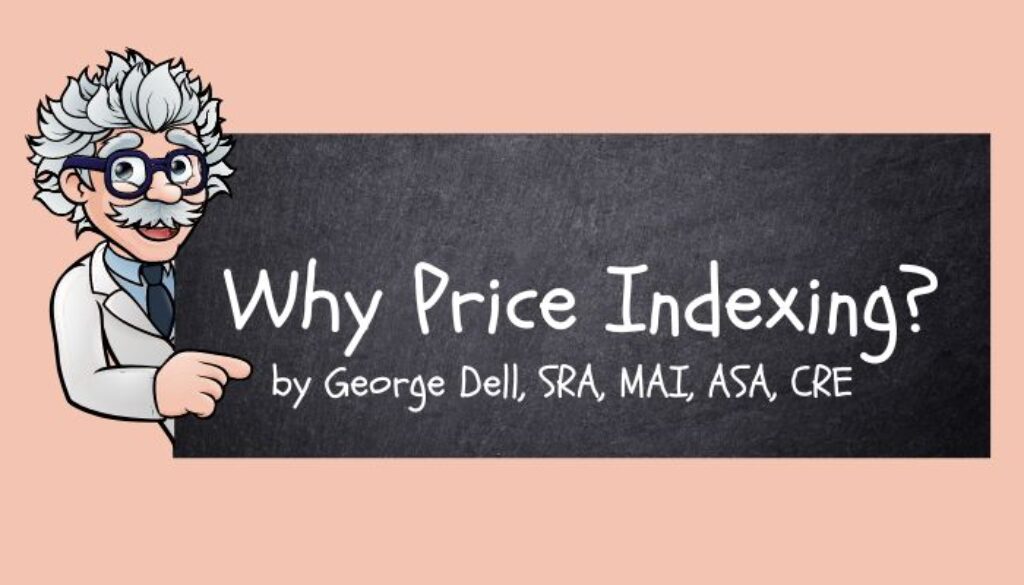Market-specific price indexing is powerful and underused!
It improves accuracy and precision of appraisals. It enables an objective market analysis. It forms a natural path from traditional, judgment-based appraisal to informative, evidence-based professional analyses. Best of all, it enables a sense of pride in appraisal work, while making it more fun!
Market Price Indexing (MPI)© optimizes today’s data technologies. It integrates expert analytic judgment (modeling) with computer logic (algorithms). Screen visualization and dashboard applications lets the analyst envision the whole market data, (not just 4 or 5 comps). It lets the user/client see directly to the data, logic, and results.
- Accuracy and precision are improved because indexing is objective, by eliminating any ‘iffy-ness’ of trend analysis. Precision (low variation or ‘sureness’) is better because given the relevant data set (of competitive sales), the result is mathematical, not judgment-based. In the same way, accuracy is improved because non-relevant data and calculations are eliminated. Analytic bias is also eliminated once the directly competitive data set is identified. (A topic for another writing). While any subjectivity or error in other adjustments remains, the overall reliability is improved.
- An expanded data set is comfortably available. Dated, yet similar comparables are validated. For example, a perfect model match, or identical property may have sold behind the usual time limits of data search. In this case, the reliable “time adjustment” can make this the best of sparse competitive sales data.
In the same way, data needed (such as contrasting, or associating other sales to support adjustments), also becomes much more reliable.
- It is visual, on top of the mathematical rigor. The scatterplot clearly allows the analyst (and the user) to see the complete market, and market trend. The simple regression line(s) help the expert eye see the trend, see coming changes in the trend, and sounds out the actual time adjustment in a day-by-day trend line. No information is discarded (as it was in the faulty residential form 1004mc).
The visual aspect in itself is important. One picture is worth 1000 words. It can be viewed in an instant. It can be trusted. Humans are exceptionally able to visualize and generalize. Ideally suited to working with measuring markets and market data in place of comparing 4 or 5 comps.
- Seven or eight sales are sufficient, although 12-15 (or more) data points provide a more reliable and visually convincing display. (Usually a small expansion beyond the directly competitive sales pulls in enough data points to establish the trend, in spite of the loss of similarity.)
- Market price indexing (MPI)© starts an ideal valuation world – human expert judgment and computer speed and exactitude in calculations and logic. The expert applies a more refined judgment to tell the computer what to do. The computer presents relevant model decisions to the human expert. Visualization, via graphs help the human see – and make the decisions to calculate for results (including dealing with uncertainties).
- Price indexing is comprehensive, as it spans the entire process of valuation – from data selection, to validation, to prediction, to reporting. Thus it is the foundation for the professional appraiser to transform to a true asset analyst. The asset analyst is the future of the profession.
Appraisers can be more than an ‘believable’ opinion — much more than just a point value opinion of two weeks ago. Much more.

July 27, 2022 @ 3:49 pm
#4 above is interesting. I would have thought that bringing in data outside of what is ideally or reasonably comparable would lead to a lowering of reliability.